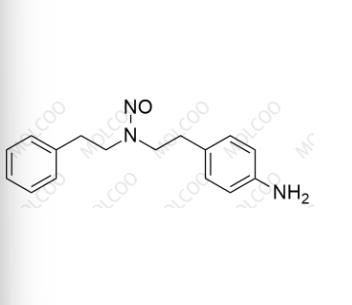Mirabeiron Nitroso Impurity 55

WhatsAPP: +86 17320513646
E-mail: anna@molcoo.com
Product Code:M005055
English Name:Mirabeiron Nitroso Impurity 55
English Alias:N-(4-aminophenethyl)-N-phenethylnitrous amide
CAS No.:Not provided
Molecular Formula:C₁₆H₁₉N₃O
Molecular Weight:269.34
High-Purity Reference Standard:Confirmed by HPLC (≥99.0%), NMR (1H, 13C), HRMS, and elemental analysis, suitable for Mirabeiron nitroso impurity analysis and quality control.
Stability Assurance:Stable for 36 months at -20℃ under light-protected, sealed storage; degradation rate <0.3% in methanol-water mixture within 6 months.
Quality Control Testing:Used for UPLC-MS/MS detection of N-nitroso Impurity 55 in Mirabeiron API and formulations, controlling content to meet ICH Q3A standards (single impurity limit ≤0.1%).
Process Optimization Research:Monitors nitroso impurity formation during Mirabeiron synthesis, reducing generation by >40% by adjusting reaction system pH (e.g., neutral to weakly alkaline) and temperature (≤35℃).
Method Validation:Serves as a standard for developing nitroso impurity detection methods, verifying UPLC resolution (≥3.0) and LOD (0.01 ng/mL).
Mirabeiron, a β3-adrenergic receptor agonist, is used for treating overactive bladder by relaxing the detrusor muscle to relieve symptoms such as urinary frequency and urgency. N-Nitroso Impurity 55, a potential genotoxic impurity (GTI), may originate from side reactions between amine compounds and nitrosating agents during production. Nitroso compounds have potential carcinogenicity, and their nitrosamide groups and phenethyl side chains may enhance interaction with DNA, making control of this impurity critical for drug safety.
Detection Technology:UPLC-MS/MS with C18 column (1.7μm) and 0.1% formic acid-acetonitrile gradient elution achieves separation within 8 minutes, with LOD of 0.002 ng/mL for trace analysis of genotoxic impurities.
Formation Mechanism:Formed by reaction of 4-aminophenethylamine and phenethylamine with nitrite under acidic conditions (e.g., pH <4); optimizing nitrosating agent residue control and post-reaction processing inhibits formation.
Safety Evaluation:In vitro Ames test shows potential mutagenicity, and in vivo mouse model tests demonstrate DNA adduct formation in bladder tissue at an 8 mg/kg dose. Accelerated stability and forced degradation tests are ongoing to systematically study degradation pathways and mutagenic risks under light, heat, and oxidation conditions.
NOTE!
We can also customize related analogues and modified peptides including HPLC, MS, 1H-NMR, MS, HPLC, IR, UV, COA, MSDS.
This product is intended for laboratory use only!
WhatsAPP: +86 17320513646
E-mail: anna@molcoo.com
NEW IN STOCK!
The Molcoo Laboratory added drug impurity reference standards, including Baricitinib, Piperazine, Benzylpenicillin, Tranilast and multiple N-Nitroso drug impurities! Now available for immediate delivery!